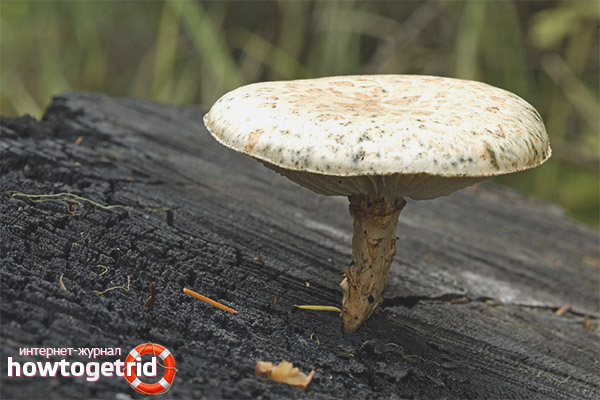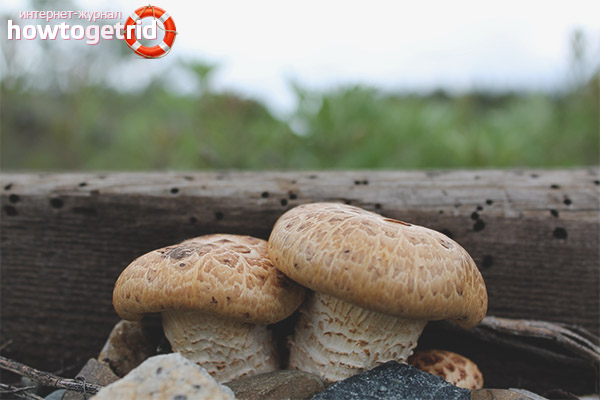The content of the article
Sleeping mushroom is an edible species of fungi belonging to the polypore family. Despite its edibility, this species is little known, so many mushroom pickers, having seen it, simply bypass it. Another name for the representatives of this species is a scaly sawlog.
View description
Young specimens of the species have a rather convex hat, which gradually melts with the growth of the fungus, forming a funnel-shaped depression in the inner part. The edges of the cap are quite thin. The diameter of this part of the fungus does not exceed 100 mm. Color ranges from dirty white to light brown with some yellowness. On a dry surface, you can clearly see small scales of brown or brownish color. Closer to the central part are flakes having larger sizes.
The lamellar body of the squamous pilolist is distinguished by plates with rather large serrations, their color varies from dirty yellow to brown. The flesh of this type of white in young specimens is dense and elastic, hardens with growing. The pulp of the fruit body has a pleasant mushroom aroma.
Leg of the correct form, one-piece, tapering to the base. The color of this part of the sleeper mushroom is dirty white, the surface is covered with small reddish scales.
Places of growth
Most often, this type of mushroom can be found growing on fallen and dead trees, in fact, representatives of this species feed on decaying wood. In addition to deadwood, stumps and fallen trees, mushroom groups can grow on various wood products, sleepers and telegraph poles, thereby destroying their structure. Note that in order to maintain the operational life of such products, the latter is coated with a special antiseptic. Nevertheless, this does not harm the pilothouse at all, who likes this “impregnation” on the contrary, which is why this species got its name - sleeper mushroom.
Where is better to collect?
Although the species of mushrooms presented to the attention is edible, nevertheless, there are hardly any people who want to try culinary delights with mushrooms growing on creosote-soaked wood. We draw attention to the fact that mushrooms growing on sleepers can be harmful to health, since they accumulate a sufficiently large amount of harmful substances that negatively affect the human body.
Therefore, if you decide to harvest a pilothouse, in this case, these mushrooms should be collected in the forest more often. For collection, it is better to choose young specimens, the preparation of which involves pickling and pickling.
Poison Doubles
Sleeping mushroom has a characteristic appearance, so it is quite difficult to confuse it with other species, at present, information about dangerous and toxic counterparts of this mushroom is not available.
Beneficial features
Due to its nutritional value, such mushrooms as squamos are widely used in oriental dishes. In addition to its nutritional value, the sleeper mushroom is also very useful; when dried, it has a good antitumor effect in the treatment of cancer.Also, the use of pilolistnik promotes the formation of useful substances, including interferon, which effectively fights many ailments of an infectious nature.
Related species
- Squiggle goblet - this mushroom is not used for cooking culinary dishes, as it is an inedible species. The hat is of a characteristic funnel-shaped, reddish-white color. Hats of adult mushrooms are usually white, due to their fading. The surface of the skin of the fruiting body is dry, covered with a small pile, the edges are uneven. The pulp is quite elastic, with a pleasant aroma of fresh fruit. The leg of the mushroom is small in size, but at the same time quite thick, almost completely covered with plates. Most often, this species grows on damaged deciduous wood.
- Tiger carpellar - the fungus belongs to the conditionally edible species. The cap of the mushroom has an asymmetric shape, funnel-shaped. The surface is dry, densely dotted with small brown scales. The leg is white, darkening closer to the base. The pulp is white in color, with a break in the fruit body, it immediately changes color and turns red. The fruiting season is from the beginning of summer to mid-autumn. Most often, this type of mushroom is found in coniferous forests among clusters of deadwood.
Video: slep mushroom (Lentinus lepideus)











Submit